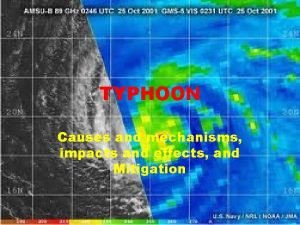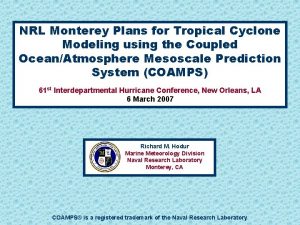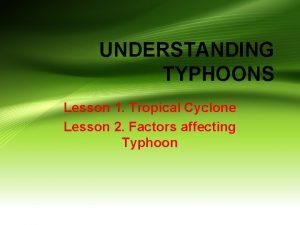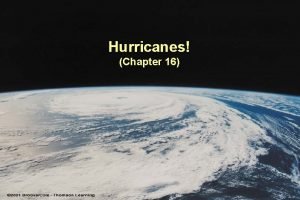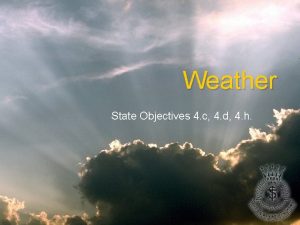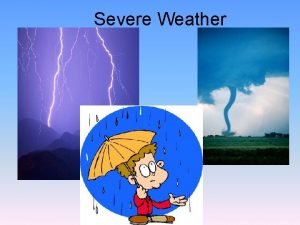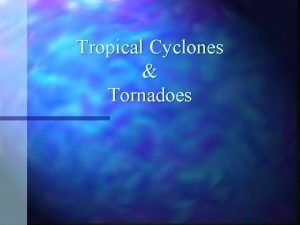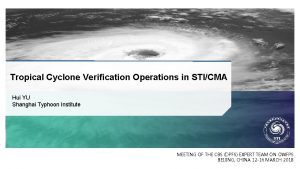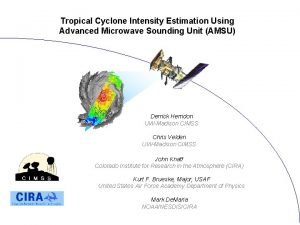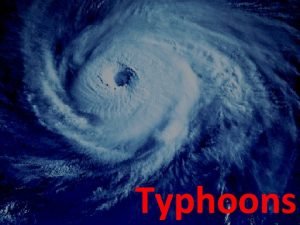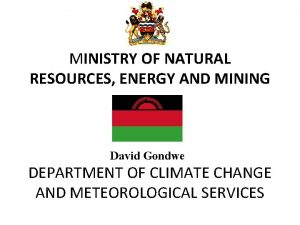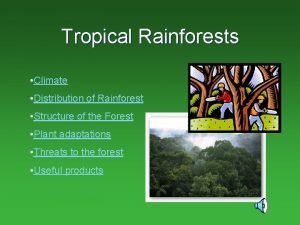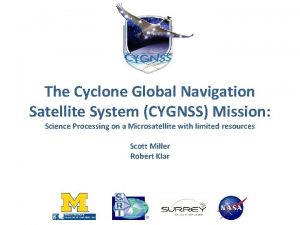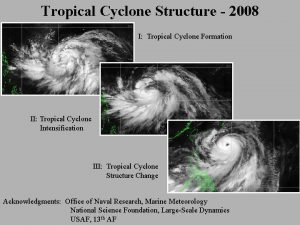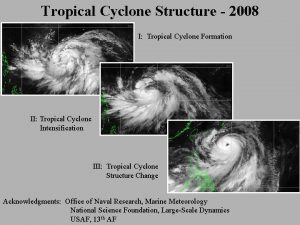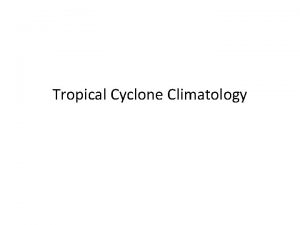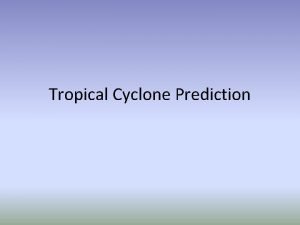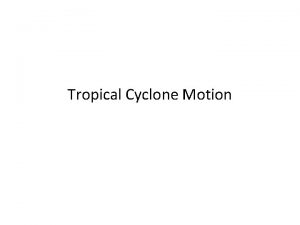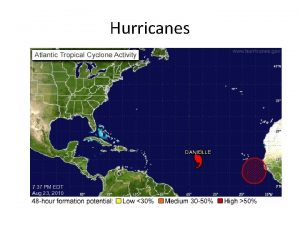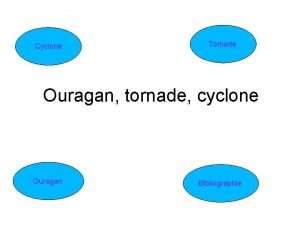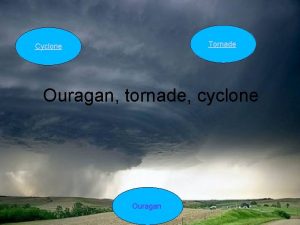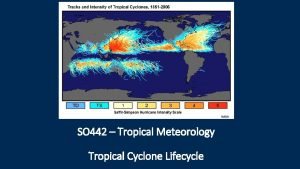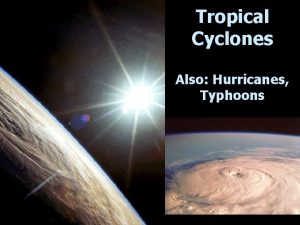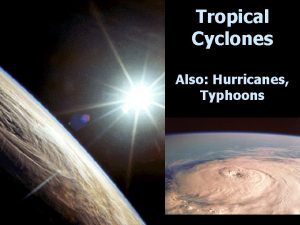Tropical Cyclone Structure 2008 I Tropical Cyclone Formation















- Slides: 15

Tropical Cyclone Structure - 2008 I: Tropical Cyclone Formation II: Tropical Cyclone Intensification III: Tropical Cyclone Structure Change Acknowledgments: Office of Naval Research, Marine Meteorology National Science Foundation, Large-Scale Dynamics USAF, 13 th AF

Key science questions to be addressed in a program aimed at increased understanding and predictability of tropical cyclone characteristics during formation, intensification, and recurvature over the western North Pacific • Highlights – Incorporates multiple space and time scales • Large scale controls – Global and basin-wide spatial scales – Medium-range and synoptic temporal scales • Mesoscale organization pathways – During formation – During intensification – Primary hypotheses with respect to: • Large-scale role in pre-conditioning • Mesoscale organizational pathways leading to construction of a potential vorticity monolith – Role of low-level convergence associated with deep convective cells – Stratiform regions of mesoscale convective systems • Relative roles of environmental and vortex structures in determining the evolution of the outer wind structure – In tandem with the THORPEX Pacific Asian Regional Campaign (TPARC)

Tropical cyclone formation, structure and structure change: Challenges to Maritime Operations • Variety of conditions from which a tropical cyclone may form over the western North Pacific Pre-TY Tokage monsoon depression TY Tokage 0000 UTC 14 October 2004 Warning graphics from the Joint Typhoon Warning Center for TY Tokage. The shaded region defines the danger area to be avoided. This area is based on the uncertainty associated with track and outer wind structure over the ensuing five days. TY Tokage: 0000 UTC 14 October 2004 Note: The danger area nearly covers the entire East China Sea for a period of at least 5 days. The change in track forecast from TY Tokage: 1200 UTC 15 October 2004 straight to recurvature, which may be due to the influence of the outer wind structure

Tropical cyclone formation, structure and structure change: Challenges to Maritime Operations • Midget tropical cyclones often develop in narrow zone along the periphery of a monsoon gyre or in association with an upper-level trough http: //www. nrlmry. navy. mil/tc_pages/tc_home. html TS Danas (11 W) 1200 UTC 8 Sep 2007 TS Danas (11 W) Danger area graphic 0000 UTC 9 Sep 2007 For this small tropical cyclone, the danger area is only 4 deg. in diameter and there is no change in track

How does the large-scale atmosphere and ocean environment control the mesoscale environment prior to tropical cyclone formation? Large-scale modes of variability Objective: medium-range predictability of the tropical large-scale environmental factors that influence tropical cyclone formation

What are the relative roles of the primary mesoscale mechanisms (bottom -up and top-down) in determining the location, timing, and rate of tropical cyclone formation in the monsoon trough environment of the tropical western North Pacific? http: //www. nrlmry. navy. mil/sat_products. html 10 o Pre-Fitow (10 W 2007) disturbance http: //www. nrlmry. navy. mil/sat_products. html 19 o Pre-Man-Yi (04 W 2007) disturbance Objective: Increased predictability associated with the location, timing, and rate of tropical cyclone formation over the western North Pacific

clo Co nes La mb Tr rge ina op a ti ic nd on al Cy Sm type cl all on es Sy n Lar optic ge Tro Type pic : al C y Synoptic Forcing What are the relative roles of environmentally-induced and vortexgenerated mechanisms versus cyclogenesis-determined initial conditions in determining the outer wind structural evolution of western North Pacific tropical cyclones? s e on e: ycl p ty l C e al pica c os Tro s Me all Sm Mesoscale Forcing Objective: Increased understanding and predictability of factors that impact the evolution of the outer-wind structure of an intensifying tropical cyclone over the western North Pacific.

What are the key structural aspects of the tropical cyclone and its environment that limit the predictability of recurvature and the start of extratropical transition over the subtropical western North Pacific? Increase in forecast uncertainty over tropical and midlatitude regions often occurs due to tropical cyclones and the movement of tropical cyclones into the midlatitudes TY Tokage, October 2004 Tracks from the JMA ensemble prediction system Tracks supplied by Dr. T. Nakazawa

Ensemble Prediction System from the European Center for Medium Range Weather Forecasts (ECMWF) 5 -Day Forecasts associated with the Extratropical Transition of TY Maemi (2003) TY Maemi Agreement among members implies high predictability Large spread among members implies decreased predictability Graphic supplied by Prof. S. Jones and D. Anwender

Satellite – Aircraft Comparisons NOAA 43 1430 -1520 Z 10, 000’ TMI 85 H 9 -22 -05 1443 Z NW North Hurricane Rita Graphic supplied by J. Hawkins

Observing Platforms (1 August – 30 September) • NRL P-3/ NCAR ELDORA/ DWL lidar/ GPS Dropwindsondes • 50/50 funding split between NSF and ONR • Operation from Andersen AFB, Guam, Kadena AFB, Okinawa, Atsugi NAF, Japan • Total of 150 research hours • 450 dropwindsondes (30 sondes per mission) • USAF Reserve 53 rd Weather Squadron (Hurricane Hunter) WC-130 J • Funding from ONR and USAF • Operation from Andersen AFB, Guam, Kadena AFB, Okinawa, Yokota AFB, Japan • Dropwindsondes • Stepped Frequency Microwave Radiometer • AXBTs, Drifting Buoys • Other Components • DOTSTAR • Driftsondes – Launch from Hawaii – 20 balloons with dropwindsonde gondolas – 40 dropwindsondes per gondola • Satellite: MTSAT rapid scan, Polar orbiting platforms

Pre- TY 10 W (Fitow) Disturbance Combined missions during tropical cyclone formation Use of Eldora to measure characteristics associated with deep convection Use of WC-130 to measure the environmental characteristics

TY Nabi, 29 Aug – 8 Sep, 2005 T-PARC/TCS-08 Components Midlatitude operating region NRL P-3, FALCON Extratropical Transition (ET – recurvature), Downstream Impacts Japan, Yokota AFB ET characteristics, forcing of downstream impacts, tropical/midlatitude interactions, extratropical cyclogenesis Subtropical operating region Driftsonde, NRL P-3, DOTSTAR, WC-130 TC track characteristics, tropical/midlatitude interaction Okinawa, Kadena AFB Guam, Andersen AFB Tropical operating region Driftsonde, NRL P-3, DOTSTAR, WC-130 TC Intensification and structure change Recurvature, initiation of ET Tropical Measurements Large-scale circulation, deep convection, monsoon depressions, tropical waves, TC formation

T-PARC and TCS-08: GLOBAL OPERATIONS Driftsonde center, Boulder, CO Okinawa Japan Taiwan Aircraft locations, and aircraft operations centers Guam Operations center, Monterey, CA Driftsonde release, Hawaii

Summary • • Much recent national and international attention on TCs Four Major Weather Forecast Problems in the Pacific Lack of understanding of storm scale processes is the biggest knowledge gap (basic research common to all four) Proposing: – First major WESTPAC field experiment since TCM 93 – First detailed observations of TC outer winds, genesis & life-cycle (in situ aircraft, radar, dropsondes, lidar, remote sensing) – First measurements. to validate new and advanced satellite obs. of WP TCs – Utilize the post-CBLAST coupled ocean-wave-atmosphere modeling system as a testbed to gain understanding of the processes as informed and constrained by the field data • Expected accomplishments: – Increase the predictability of the environmental forcing, formation, outer wind structure and intensity of TCs over the western North Pacific – Leverage several international efforts – GOAL: to reduce errors in TC structure and intensity forecasts by 50% within a decade – will also increase warning times and improve ocean and wave forecasts
 Formative stage of typhoon
Formative stage of typhoon Nrl monterey tropical cyclone
Nrl monterey tropical cyclone Understanding typhoons
Understanding typhoons Hurricane cross section
Hurricane cross section Parts of tropical cyclone
Parts of tropical cyclone Tornado alley map
Tornado alley map How does a typhoon form
How does a typhoon form Tropical cyclone tornadoes
Tropical cyclone tornadoes Sticma
Sticma Tropical cyclone
Tropical cyclone A recipe of a tropical cyclone
A recipe of a tropical cyclone Mining
Mining 2008 2008
2008 2008 Formation initiale vs formation continue
Formation initiale vs formation continue Structure of tropical rainforest
Structure of tropical rainforest Cyclone global navigation satellite system
Cyclone global navigation satellite system
